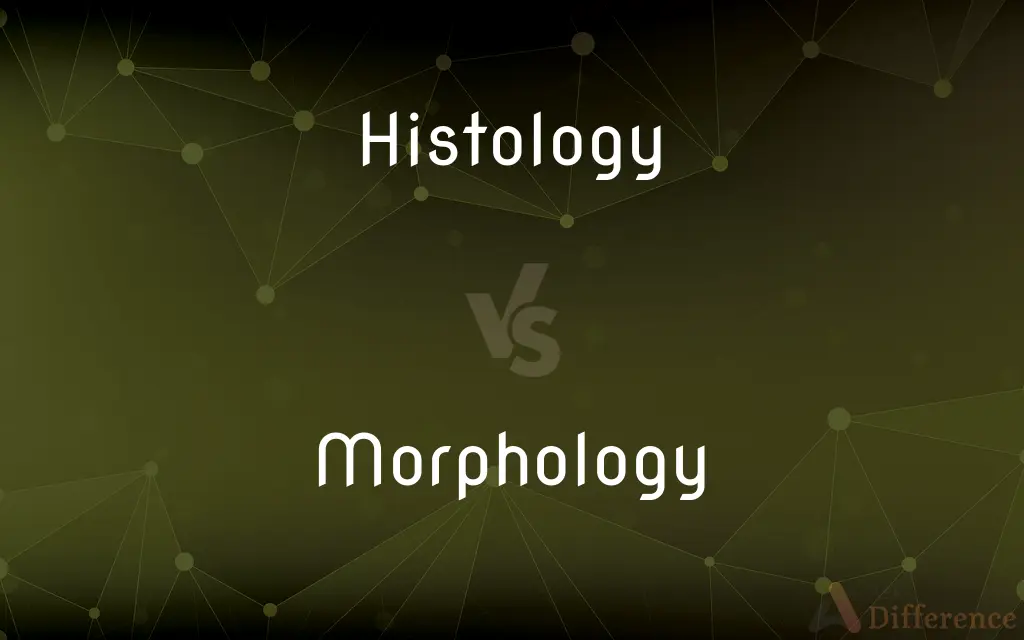Histology vs. Morphology — What's the Difference?
Edited by Tayyaba Rehman — By Maham Liaqat — Updated on March 25, 2024
Histology studies the microscopic structure of tissues in plants and animals, while morphology examines the form and structure of organisms and their specific structural features at various scales.

Difference Between Histology and Morphology
Table of Contents
ADVERTISEMENT
Key Differences
Histology is a branch of biology and medicine that focuses on the microscopic examination of tissue samples to understand their structure, composition, and function. Morphology, on the other hand, is a broader field that encompasses the study of the form and structure of organisms at all levels, from the macroscopic to the microscopic.
While histology is more narrowly focused on the microscopic architecture of tissues, morphology provides a broader perspective on the structural aspects of organisms. Histology is essential for medical diagnosis and research, offering insights into the cellular level of organization and how diseases affect the body. Morphology, by encompassing both the microscopic and macroscopic levels, provides a comprehensive view of the structural diversity and adaptations in the biological world, contributing to fields such as evolutionary biology, taxonomy, and functional anatomy.
The intersection of histology and morphology is evident in the study of tissue structure and organization. Histological techniques allow morphologists to examine the finer details of tissues and organs, enhancing the understanding of their function and evolution. Conversely, morphological studies provide a contextual framework that informs histological analysis, linking cellular structures to the overall form and function of organisms.
Histology delves into the microscopic structure of tissues, providing critical insights for medical science and biological research, morphology offers a wider lens on the form and structure of organisms, exploring the diversity and adaptations of life at various scales. Both disciplines are integral to the comprehensive study of biology, each contributing unique perspectives on the organization and function of living systems.
Comparison Chart
Focus
Microscopic structure of tissues.
Form and structure of organisms at various scales.
ADVERTISEMENT
Techniques
Microscopy, staining.
Comparative analysis, dissection, imaging techniques.
Application
Disease diagnosis, cellular organization research.
Evolutionary biology, taxonomy, functional anatomy.
Scope
Narrower, focused on tissue level.
Broader, covering both macroscopic and microscopic.
Sub-disciplines
None specified; closely related to pathology.
Anatomical morphology, comparative morphology.
Compare with Definitions
Histology
Essential for medical diagnosis and biological research.
Histological analysis revealed the early stages of disease in the biopsy.
Morphology
Covers structural development and function.
Plant morphology investigates how leaf shapes are adapted to different environmental conditions.
Histology
Focuses on cellular organization within tissues.
Histology helps understand how cancer cells differ from normal tissue.
Morphology
Comparative aspect highlights evolutionary relationships.
Comparative morphology can trace the limb structures of terrestrial animals back to common ancestors.
Histology
Contributes to anatomy and physiology understanding.
Histological studies provide insights into the complex structure of the human brain.
Morphology
Informs taxonomy and evolutionary biology.
Morphological traits are often used to classify species and understand their evolutionary history.
Histology
Utilizes techniques like staining and microscopy.
Fluorescent staining in histology allows for detailed observation of cellular components.
Morphology
The study of form and structure of organisms.
Morphology examines the adaptations of bird beaks to their feeding habits.
Histology
Histology, also known as microscopic anatomy or microanatomy, is the branch of biology which studies the microscopic anatomy of biological tissues. Histology is the microscopic counterpart to gross anatomy, which looks at larger structures visible without a microscope.
Morphology
Encompasses both external and internal structures.
The morphology of fish includes studying their streamlined body shape for efficient swimming.
Histology
The study of the microscopic structure of tissues.
Morphology
The branch of biology that deals with the form and structure of organisms without consideration of function.
Histology
The anatomical study of the microscopic structure of animal and plant tissues.
Morphology
The study of the forms of things.
Histology
The microscopic structure of tissue.
Morphology
A particular form, shape, or structure.
Histology
(biology) The study of the microscopic structure, chemical composition and function of the tissue or tissue systems of plants and animals.
Morphology
The form and structure of an organism or one of its parts
The morphology of a cell.
The morphology of vertebrates.
Histology
That branch of biological science, which treats of the minute (microscopic) structure of animal and vegetable tissues; - called also histiology.
Morphology
(Linguistics) The study of the structure and form of words in language or a language, including inflection, derivation, and the formation of compounds.
Histology
The branch of biology that studies the microscopic structure of animal or plant tissues
Morphology
(uncountable) A scientific study of form and structure, usually without regard to function. Especially:
Morphology
(linguistics) The study of the internal structure of morphemes (words and their semantic building blocks).
Morphology
(biology) The study of the form and structure of animals and plants.
Morphology
(geology) The study of the structure of rocks and landforms.
Morphology
(math) Mathematical morphology.
Morphology
(countable) The form and structure of something.
Morphology
(countable) A description of the form and structure of something.
Morphology
That branch of biology which deals with the structure of animals and plants, treating of the forms of organs and describing their varieties, homologies, and metamorphoses. See Tectology, and Promorphology.
Morphology
The form and structure of an organism.
Morphology
The branch of linguistics which studies the patterns by which words are formed from other words, including inflection, compounding, and derivation.
Morphology
The study of the patterns of inflection of words or word classes in any given language; the study of the patterns in which morphemes combine to form words, and the rules for combination; morphemics; as, the morphology of Spanish verbs; also, the inflection patterns themselves.
Morphology
The branch of biology that deals with the structure of animals and plants
Morphology
Studies of the rules for forming admissible words
Morphology
The admissible arrangement of sounds in words
Morphology
The branch of geology that studies the characteristics and configuration and evolution of rocks and land forms
Common Curiosities
How do histological techniques aid in disease diagnosis?
Histological techniques, such as staining and microscopy, allow for the detailed observation of tissue samples, helping identify abnormalities at the cellular level that indicate disease.
Are morphology and anatomy the same?
Anatomy is a broader term that includes the study of the structure of organisms, while morphology focuses specifically on form and structure, including both external and internal features.
How does morphology contribute to evolutionary biology?
Morphology provides evidence of evolutionary relationships through comparative studies of form and structure across different species.
What role does histology play in cancer research?
Histology is crucial in cancer research for diagnosing different types of tumors, understanding cancer progression, and developing targeted therapies.
Can histology reveal anything about an organism's function?
Yes, by examining tissue structure, histology can provide insights into how organs function and how diseases may affect these functions.
How do new imaging techniques impact the field of histology?
Advanced imaging techniques have enhanced the resolution and detail with which tissues can be studied, opening up new avenues for research and diagnosis.
Can histology be used to study plants?
Yes, histology applies to both animal and plant tissues, studying their cellular organization and function.
Why is the study of morphology important in taxonomy?
Morphology provides the physical characteristics used to classify organisms into different taxonomic groups, aiding in the identification and understanding of biodiversity.
What is the significance of comparative morphology?
Comparative morphology helps understand evolutionary trends, adaptations, and functional mechanisms by comparing the structures of different organisms.
What challenges do morphologists face in classifying organisms?
Morphologists often deal with the complexity of phenotypic plasticity, convergent evolution, and cryptic species, which can complicate classification efforts.
Share Your Discovery

Previous Comparison
Lacquer vs. Resin
Next Comparison
Brunch vs. BreakfastAuthor Spotlight
Written by
Maham LiaqatEdited by
Tayyaba RehmanTayyaba Rehman is a distinguished writer, currently serving as a primary contributor to askdifference.com. As a researcher in semantics and etymology, Tayyaba's passion for the complexity of languages and their distinctions has found a perfect home on the platform. Tayyaba delves into the intricacies of language, distinguishing between commonly confused words and phrases, thereby providing clarity for readers worldwide.














































